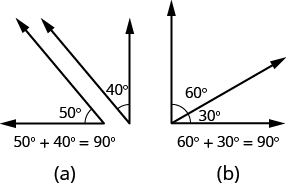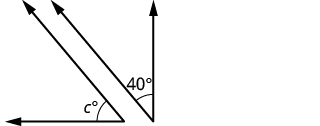Using Properties of Angles to Solve Problems
Learning Outcomes
- Find the supplement of an angle
- Find the complement of an angle
 An angle is formed by two rays that share a common endpoint. Each ray is called a side of the angle and the common endpoint is called the vertex. An angle is named by its vertex. In the image below, [latex]\angle A[/latex] is the angle with vertex at point [latex]A[/latex]. The measure of [latex]\angle A[/latex] is written [latex]m\angle A[/latex].
An angle is formed by two rays that share a common endpoint. Each ray is called a side of the angle and the common endpoint is called the vertex. An angle is named by its vertex. In the image below, [latex]\angle A[/latex] is the angle with vertex at point [latex]A[/latex]. The measure of [latex]\angle A[/latex] is written [latex]m\angle A[/latex].
[latex]\angle A[/latex] is the angle with vertex at [latex]\text{point }A[/latex].

We measure angles in degrees, and use the symbol [latex]^ \circ[/latex] to represent degrees. We use the abbreviation [latex]m[/latex] to for the measure of an angle. So if [latex]\angle A[/latex] is [latex]\text{27}^ \circ [/latex], we would write [latex]m\angle A=27^ \circ[/latex].
If the sum of the measures of two angles is [latex]\text{180}^ \circ[/latex], then they are called supplementary angles. In the images below, each pair of angles is supplementary because their measures add to [latex]\text{180}^ \circ [/latex]. Each angle is the supplement of the other.
The sum of the measures of supplementary angles is [latex]\text{180}^ \circ [/latex].

 If the sum of the measures of two angles is [latex]\text{90}^ \circ[/latex], then the angles are complementary angles. In the images below, each pair of angles is complementary, because their measures add to [latex]\text{90}^ \circ[/latex]. Each angle is the complement of the other.
The sum of the measures of complementary angles is [latex]\text{90}^ \circ[/latex].
If the sum of the measures of two angles is [latex]\text{90}^ \circ[/latex], then the angles are complementary angles. In the images below, each pair of angles is complementary, because their measures add to [latex]\text{90}^ \circ[/latex]. Each angle is the complement of the other.
The sum of the measures of complementary angles is [latex]\text{90}^ \circ[/latex].

Supplementary and Complementary Angles
If the sum of the measures of two angles is [latex]\text{180}^\circ [/latex], then the angles are supplementary.If angle [latex]A[/latex] and angle [latex]B[/latex] are supplementary, then [latex]m\angle{A}+m\angle{B}=180^\circ[/latex].
If the sum of the measures of two angles is [latex]\text{90}^\circ[/latex], then the angles are complementary.If angle [latex]A[/latex] and angle [latex]B[/latex] are complementary, then [latex]m\angle{A}+m\angle{B}=90^\circ[/latex].
Use a Problem Solving Strategy for Geometry Applications.
- Read the problem and make sure you understand all the words and ideas. Draw a figure and label it with the given information.
- Identify what you are looking for.
- Name what you are looking for and choose a variable to represent it.
- Translate into an equation by writing the appropriate formula or model for the situation. Substitute in the given information.
- Solve the equation using good algebra techniques.
- Check the answer in the problem and make sure it makes sense.
- Answer the question with a complete sentence.
example
An angle measures [latex]\text{40}^ \circ[/latex]. 1. Find its supplement 2. Find its complement Solution| 1. | |
| Step 1. Read the problem. Draw the figure and label it with the given information. |  |
| Step 2. Identify what you are looking for. | The supplement of a [latex]40°[/latex]angle. |
| Step 3. Name. Choose a variable to represent it. | Let [latex]s=[/latex]the measure of the supplement. |
| Step 4. Translate. Write the appropriate formula for the situation and substitute in the given information. | [latex]m\angle A+m\angle B=180°[/latex] [latex]s+40°=180°[/latex] |
| Step 5. Solve the equation. | [latex]s=140°[/latex] |
| Step 6. Check: [latex-display]140°+40°\stackrel{?}{=}180°[/latex-display] [latex]180°=180°\checkmark[/latex] | |
| Step 7. Answer the question. | The supplement of the [latex]40°[/latex]angle is [latex]140°[/latex]. |
| 2. | ||
| Step 1. Read the problem. Draw the figure and label it with the given information. |  |
|
| Step 2. Identify what you are looking for. |
|
|
| Step 3. Name. Choose a variable to represent it. | Let [latex]c=[/latex]the measure of the complement. | |
| Step 4. Translate. Write the appropriate formula for the situation and substitute in the given information. | [latex]m\angle A+m\angle B=90°[/latex] | |
| Step 5. Solve the equation. | [latex]c+40°=90°[/latex] [latex]c=50°[/latex] | |
| Step 6. Check: [latex-display]50°+40°\stackrel{?}{=}90°[/latex-display] [latex]90°=90°\quad\checkmark[/latex] | ||
| Step 7. Answer the question. | The complement of the [latex]40°[/latex]angle is [latex]50°[/latex]. |
try it
[ohm_question]146495[/ohm_question]Exercises
Two angles are supplementary. The larger angle is [latex]\text{30}^ \circ[/latex] more than the smaller angle. Find the measure of both angles.Answer: Solution:
| Step 1. Read the problem. Draw the figure and label it with the given information. |  |
| Step 2. Identify what you are looking for. | The measures of both angles. |
| Step 3. Name. Choose a variable to represent it. The larger angle is 30° more than the smaller angle. | Let [latex]a=[/latex] measure of smaller angle [latex]a+30=[/latex] measure of larger angle |
| Step 4. Translate. Write the appropriate formula and substitute. | [latex]m\angle A+m\angle B=180[/latex] |
| Step 5. Solve the equation. | [latex](a+30)+a=180[/latex] [latex-display]2a+30=180[/latex-display] [latex-display]2a=150[/latex-display] [latex]a=75=[/latex] measure of smaller angle. [latex]a+30=[/latex] measure of larger angle. [latex-display]75+30[/latex-display] [latex]105[/latex] |
| Step 6. Check: [latex-display]m\angle A+m\angle B=180°[/latex-display] [latex-display]75°+105°\stackrel{?}{=}180°[/latex-display] [latex]180°=180°\quad\checkmark[/latex] | |
| Step 7. Answer the question. | The measures of the angle are [latex]75°[/latex]and [latex]105°[/latex]. |
try it
[ohm_question]146496[/ohm_question] [ohm_question]146497[/ohm_question]Contribute!
Did you have an idea for improving this content? We’d love your input.
Licenses & Attributions
CC licensed content, Original
- Question ID 146497, 146496, 146495. Authored by: Lumen Learning. License: CC BY: Attribution.
CC licensed content, Shared previously
- Determine the Complement and Supplement of a Given Angle. Authored by: James Sousa (mathispower4u.com). License: CC BY: Attribution.
CC licensed content, Specific attribution
- Prealgebra. Provided by: OpenStax License: CC BY: Attribution. License terms: Download for free at http://cnx.org/contents/[email protected].
